
June 9, 2025—A humid afternoon turns dark. The wind picks up. You hear the first low rumble of thunder—or get an alert on your phone warning of a possible tornado nearby.
Whether you're on a walk, driving or relaxing at home, knowing what to do when a storm hits can protect you and the people you care about. These tips from the American Red Cross, Centers for Disease Control and Prevention, and Ready.gov can help.
What to do during a thunderstorm
If you're outside: When you hear thunder, seek shelter immediately. The safest place is a sturdy building with walls and a foundation. Avoid structures like sheds, gazebos and bleachers. They don't give you enough protection.
If you're caught outdoors without shelter nearby, take the following safety steps:
- Move to a hard-top car and keep the windows rolled up. (A car isn't exactly a safe place, but it's less dangerous than being outside.)
- Stay far away from trees and poles. Lightning strikes the tallest objects first.
- Avoid bodies of water. Never try to drive or swim through floodwater.
If you're indoors: Be prepared for the possibility of a power outage—keep a flashlight handy, and listen for updates using a battery-powered radio if you have one. Stay clear of windows and doors to protect yourself from shattering glass.
Many people may not realize this, but lightning strikes happen indoors too. It can travel through plumbing or electrical systems. To stay safe throughout the storm:
- Don't use electronics plugged into wall outlets. (Wireless devices are fine.)
- Avoid showering, washing dishes or using faucets.
Lightning can strike over long distances. Wait at least 30 minutes after hearing the last thunderclap before going back outside.
Staying safe in a tornado
During a tornado, take extra steps to stay safe. Head to the basement as soon as you hear a tornado siren, see a tornado warning or notice signs one might be coming, like:
- A green sky.
- Wall clouds.
- Large hail.
- A sound like a freight train.
No basement? Pick the lowest interior room with no windows, such as a bathroom or laundry room. If you live in a manufactured home, go to the nearest storm shelter or sturdy building.
During a tornado, protect yourself from flying debris by covering your head and neck with your arms (as in the duck and cover position). If you can, shelter under a sturdy table or with mattresses or blankets.
Stay tuned to storm updates or detailed warnings online or through local radio and TV reports.
In your car during a tornado? If you absolutely can't drive to a sturdy building, park your car out of traffic lanes and away from overpasses and bridges. If you stay in the car, wear your seatbelt and duck below the windows. Shield your head with your hands, a blanket or a coat if possible.
Or get out of the car and lie flat with your hands over your head in a ditch or ravine, away from trees. Do the same if you're outdoors and far from shelter when a tornado strikes.
Do you have a disaster plan?
Knowing what to do during a storm can help you stay safe and protect those around you. Planning ahead can help ensure your family knows what to do when the unexpected happens. And it can ensure you have the supplies you need ready to go. Learn more in our Disaster Preparedness topic center.
Sources
- American Red Cross. "Thunderstorm Preparedness Checklist." https://www.redcross.org/content/dam/redcross/get-help/pdfs/thunderstorm/EN_Thunderstorm-Safety-Checklist.pdf.
- Centers for Disease Control and Prevention. "Safety Guidelines: During a Tornado." https://www.cdc.gov/tornadoes/safety/stay-safe-during-a-tornado-safety.html.
- Centers for Disease Control and Prevention. "Safety Guidelines: Lightning." https://www.cdc.gov/lightning/safety/index.html.
- Department of Homeland Security. "Thunderstorms & Lightning." https://www.ready.gov/thunderstorms-lightning.
- Department of Homeland Security. "Tornadoes." https://www.ready.gov/tornadoes.